In this Article
Determining the right golf stance width is essential for balance, mechanics and shot success. This guide examines how to choose between a wide vs narrow golf stance based on your physical attributes, swing tempo and desired shot shape. Get tips on optimizing foot positioning for power, consistency and precision.
One of the most important yet often overlooked fundamentals of a proper golf swing is your stance width – specifically how wide or narrow you position your feet. Your golf stance serves as the foundation for your swing, impacting everything from balance and weight transfer to the rotation of your hips and shoulders. While some golfers prefer a wider stance and others opt for a narrower stance, there is no definitive answer as to which is inherently “better”. The optimal stance width is the one that allows you to consistently make solid contact with the ball.
When we talk about stance width in golf, a wide stance generally positions the feet flared out further from the target line, usually about shoulder-width apart or slightly wider. With a wide stance, there is more space between the feet. A narrow stance brings the feet closer together, sometimes even with the feet touching or nearly touching. This creates a more compact base.
The choice between a wide vs. narrow golf stance depends on your body type, flexibility, swing mechanics, and the club you’re using. A wider stance offers more stability and engages your core muscles for power, while a narrower stance enhances control and rhythm. The proper stance width for you is the one that keeps your balance centered throughout the swing. Experiment to find your optimal foot positioning.
Choosing the right stance width is crucial for maintaining proper balance, weight shift, and posture during your golf swing. This article will examine the distinctions between a wide and narrow stance, when to use each one, and provide tips to determine and refine your ideal stance for consistency.
Table of Contents
What is Stance Width in Golf?
When setting up for a golf swing, one of the key elements is your stance width – how wide or narrow you position your feet. Your stance serves as the foundation for the swing, so proper width is critical for balance, weight shift, and consistency. There are two main varieties of stance width in golf – wide and narrow.
Wide Stance
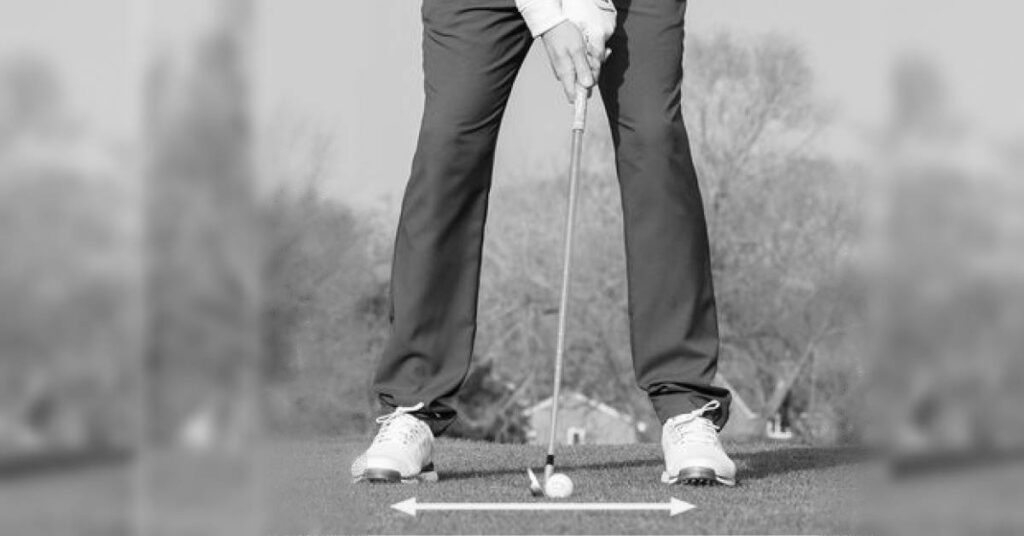
A wide stance positions the feet flared outward from the target line about shoulder-width apart or slightly wider. With a wide golf stance, there is more space between the feet rather than having them close together. Some characteristics of a wide stance include:
- Feet are aligned approximately shoulder-width or slightly wider
- Knees are flexed laterally out over feet
- Weight is distributed evenly between both feet
- Wider base of support under shoulders
The advantages of a wide stance include:
- Improved stability and balance
- More engaged core muscles and lower body
- Allows bigger shoulder turn and hip rotation
- Generates more power and clubhead speed
- Helps keep the center of gravity steady
Potential drawbacks of an excessively wide stance are:
- Can restrict the backswing and follow through
- Reduces flexibility and lower body movement
- More likelihood of swaying off the ball
- Not as much room for adjustments
Overall, a wide stance promotes stability and power while potentially limiting flexibility.
Narrow Stance
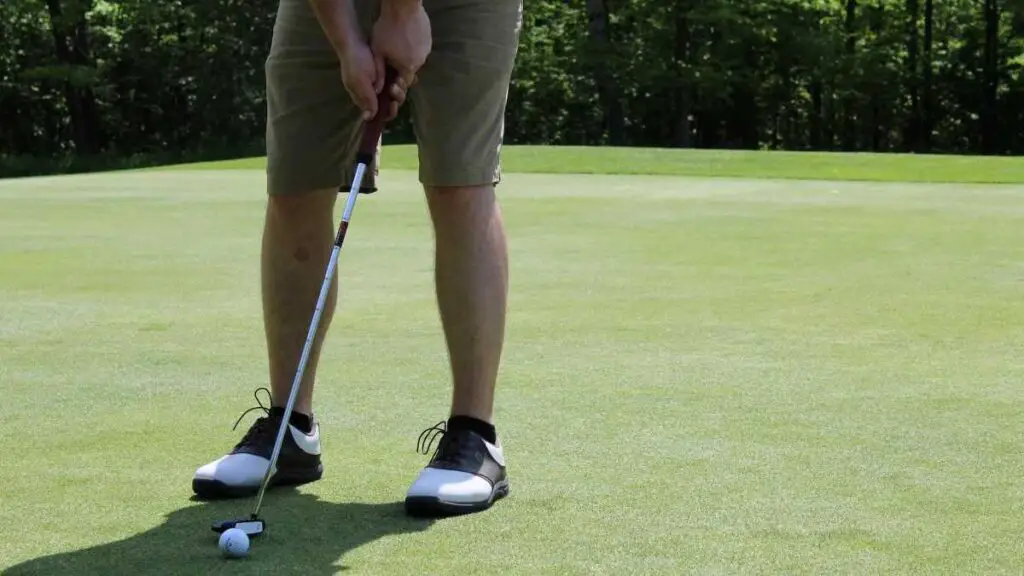
A narrow stance positions the feet closer together pointing toward the target. Some characteristics include:
- Feet nearly touching or several inches apart
- Knees pointed forward over feet
- Weight balanced between balls of feet
- Less lateral space between feet
The benefits of a narrower stance are:
- Better control and rhythm in the swing
- Allows fuller shoulder turn and flexibility
- Enhances ability to adjust swing path
- More accuracy for shorter clubs and shots
The downsides of an excessively narrow stance can be:
- Less stability during the swing
- Reduced power and balance
- More likelihood of swaying backward
- Falling backward if weight shifts too far
A narrower stance prioritizes control, rhythm, and flexibility over maximum power.
Factors that Determine Ideal Stance Width
Choosing your optimal stance width depends on several factors related to your physical build, swing mechanics, and the shot you’re trying to hit. Determining the proper foot positioning for you requires taking these variables into account.
Body Type and Size
Your physical proportions significantly influence how wide or narrow your stance should be for optimal performance.
- Taller and bigger golfers generally benefit from a wider stance. Their longer limbs and torso need the additional base of support.
- Shorter and smaller golfers are better served by a relatively narrower stance. Too wide a stance could restrict their ability to make a full turn.
- Arm length also impacts ideal width. Golfers with longer arms may opt for a narrower stance for adequate shoulder turn. Shorter-armed players can stance wider.
The goal is to find a stance width that lets you effectively coil and uncoil your body during the swing. Your physical build determines how wide or narrow that stance should be.
Swing Style and Tempo
Your swing characteristics and mechanics should factor into your stance width.
- Golfers with a longer, more aggressive transition typically need a wider base. This provides stability and engages the lower body to prevent swaying.
- Players with a short, compact swing favor a narrower stance. Wider foot positioning could restrict their backswing and limit mobility.
- Fast, forceful swingers generate more power and require sturdier support from a wider stance.
- Slower, smooth swingers rely more on rhythm and flexibility, achieved better with a narrow stance.
Experiment to find the foot positioning that complements your unique swing tempo, transition, and mechanics. A wide or narrow stance can either enhance or inhibit your optimal swing plane.
Properly matching stance width with your swing style and physical characteristics allows you to swing freely while maintaining balance and stability. This is the key to both power and consistency.
Club Being Used
The club you are using should influence your stance width. Wider and narrower stances each have advantages for different clubs.
Wider Stance for Driver and Woods
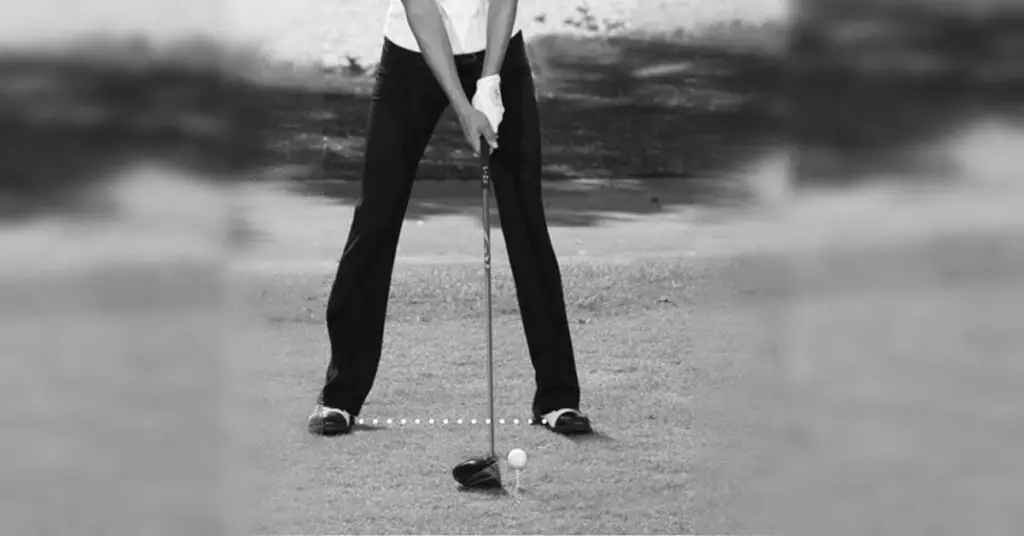
The driver and woods require power and stability, best achieved with a wider stance.
- Feet should align just outside shoulder-width to allow full hip and shoulder turn.
- Wider base engages core muscles more to prevent swaying and maximize clubhead speed.
- Extended arms of driver swing need sturdy base support from wider stance.
- Promotes consistency to make a solid impact with driver’s large sweet spot.
Narrower Stance for Wedges and Short Irons
Wedges and short irons demand finesse, control, and flexibility with a narrower stance.
- Feet positioned just inside shoulder width for upright posture.
- Narrow enough to permit adjusting the swing path for trajectory.
- Provides rhythm and feel for delicate wedge shots and pitches.
- Upper body can freely rotate more with feet positioned closer together.
Matching stance width to the club enhances power and precision.
Course Conditions
The conditions you are playing in should also impact your choice of stance width.
Wider Stance for Long Shots and Windy Conditions
A wider stance helps maintain balance and power for long shots and windy conditions.
- Feet flared wider apart lower center of gravity for stability in wind.
- Allows full shoulder turn and coil to generate maximum clubhead speed.
- Extra base support prevents swaying and sliding on long driver swings.
Narrower Stance for Tight Lies and Accuracy
A narrower stance provides control and accuracy for tight lies requiring precision.
- Feet closer together enhances the ability to manipulate trajectory.
- Allows adjusting swing plane for finesse shots from tight lies.
- Promotes minimal lateral movement for accuracy into tight landing areas.
Adjusting stance width based on conditions improves shot outcomes.
Benefits of a Wider Stance
Utilizing a wider stance during your golf swing can provide several advantages compared to a narrower stance. Understanding these benefits allows you to determine when implementing a wide foot position could improve your mechanics and shot outcomes.
Increased Stability and Balance
One of the main benefits of a wide stance is enhanced stability and balance throughout the golf swing. With your feet flared farther apart, you create a wider base of support under your shoulders. This lowers your center of gravity and strengthens your foundation.
Specific ways a wide stance improves stability include:
- Feet set wider apart widen your base and enhance balance. This prevents teetering and toppling over during the swing.
- A wider stance engages your core abdominal and lower body muscles more. Your thighs and glutes stabilize your pelvis against excess lateral slide.
- With a wide stance, you can flex your knees outward more, lowering your body for stability. This resists swaying off the ball on the downswing.
- The wider base keeps your upper body centered optimally above your feet. This allows rotating powerfully while maintaining balance.
By lowering your center of gravity and engaging your core muscles, a wide stance provides a sturdy foundation to swing from. This builds stability and balance for consistency.
Power and Distance
In addition to stability, a wide stance can increase power and distance in your golf swing. With feet set wider, you can make a bigger shoulder turn on the backswing, coiling your body more. This builds potential power to be unleashed on the downswing.
Specific ways a wide stance generates power include:
- The wider base allows your hips to rotate more on the backswing. This winds your core muscles to store elastic energy.
- Your shoulders can turn farther back with a wide stance, increasing the shoulder coil. This builds torque to be released for speed.
- More space between the feet enables dropping the club inside on the downswing for maximum width across the ball. This width generates clubhead speed.
- With feet flared wider, you can transfer weight more aggressively from back to front, adding momentum to the clubhead.
- The stability from a wide stance allows forceful uncoiling for power without losing balance.
By facilitating a bigger backswing and aggressive weight shift, a wide stance promotes clubhead speed and greater driving distance.
Better Weight Transfer
In addition to increased stability and power, a wider stance can also improve weight transfer during the golf swing. Efficient weight shift is essential for both power and accuracy.
With a wide stance, your sway and lateral movement are reduced, allowing smoother shifting of weight to your front side. Benefits of weight transfer include:
- The wider stance provides a sturdy base to push off from during the downswing. This helps properly transfer weight to the lead side.
- Feet flared farther apart helps restrict excessive lateral slide or swaying. This allows forward weight transfer instead of swaying away from the ball.
- With a wide stance, you can flex knees outward for lateral stability. This allows aggressive driving of weight to the front foot through impact.
- The strength in your lower body activated by a wide stance helps control weight transfer tempo and sequence.
By limiting sway and engaging your legs, a wide stance facilitates an ideal weight shift for power and consistency.
Consistent Ball Contact
Proper weight shift also contributes to consistent ball contact, another benefit of a wide stance. With your weight centered optimally, you can make a crisp impact with the ball.
Benefits for contact include:
- A wide stance centers your upper body solidly over feet, promoting correct ball contact. This minimizes mishits and chunked shots.
- Effective weight transfer enabled by a wide base keeps the clubhead descending properly into the ball at impact. This avoids thin shots.
- With restricted swaying from a wide stance, the clubhead meets the ball consistently on every swing. You avoid whiffs from swaying laterally.
- Solid platform provided by a wide stance allows confidently swinging through the ball without losing balance.
By keeping you balanced over the ball, a wide stance facilitates solid contact and eliminates mishits.
Using a wide stance provides stability, power, efficient weight shift, and consistent contact. Analyze when these benefits could improve your swing mechanics and shot results.
Benefits of a Narrower Stance
While a wide stance offers stability and power, using a relatively narrower stance during your golf swing can also provide advantages in certain situations. Understanding the benefits of a narrow stance allows you to determine when to utilize this foot positioning.
Improved Accuracy
One of the main benefits of a narrow stance is increased accuracy and precision in ball-striking. With feet set closer together, you have less room for error in your swing mechanics and alignment.
Specific ways a narrow stance improves accuracy include:
- Less space between feet enhances proprioception of body positioning for precise mechanics. This promotes neutral path and face alignment.
- Standing closer to the ball fosters optimal spine tilt and angle of attack for accurate impact. Weight can cover the ball better.
- With a narrow stance, swaying side to side is reduced, allowing a smaller swing arc. This permits fine-tuning the swing path.
- Narrow base enables finer adjustments to foot positioning, spine angle, and ball position for precision.
- Compact, upright posture from a narrow stance provides a better vision of the target line. This enhances accuracy.
By reducing the margin for error and allowing finer adjustments, a narrow stance facilitates more accurate ball striking and precise shot shaping.
More Flexibility
In addition to accuracy, increased flexibility is another advantage of using a narrower stance during your golf swing. The compact base allows freer shoulder and arm movement.
Specific ways a narrow stance improves flexibility include:
- Feet closer together allow greater shoulder rotation and fuller arm swing arc. This permits optimal extension and width in the backswing.
- A narrow stance keeps the torso more upright, reducing resistance on the backswing and follow-through. This increases the range of motion.
- With less lateral stability demanded, the spine and knees can flex and tilt more freely. This creates looser, fluid motion.
- Closer foot positioning fosters vertical movement into ankles and knees for smoother weight transfer.
- Reduced frame width atop feet eliminates restrictions to mobility.
The compact nature of a narrow stance provides golfers more latitude to swing freely and fully. This flexibility can increase clubhead speed.
Faster Swing Speed
In fact, increased clubhead speed is another notable benefit of using a narrower stance during the golf swing. The compact mechanics allow accelerating the club faster.
Ways a narrow stance produces speed include:
- Closer foot positioning promotes faster rotation of core muscles to build momentum. Tighter coil and uncoil increase speed.
- With less lateral stability required, full release of hips and shoulders is easier. This forceful uncoiling elevates speed.
- Streamlined posture and mechanics are possible with a narrow stance to reduce resistance, facilitating faster motion.
- Freed-up torso and limited sway put the entire body mass into motion for speed.
- Freer arms enabled by narrow stance provide whip-like action for greater club speed.
The efficiency of motion with a narrow stance lets golfers swing the club faster for added power and distance.
Better for Finesse Shots
Additionally, a narrow stance is advantageous for finesse shots requiring greater precision and touch. The tighter mechanics lend themselves to specialty shots.
Benefits for finesse shots include:
- Streamlined motion makes it easier to control face angle and manipulate trajectories.
- Freed-up shoulders and minimal sway improve trajectory manipulation on shots around greens.
- Ability to adjust ball position finely is enhanced by a narrow stance. This aids in hitting delicate shots.
- Upright posture improves vision for accurately judging distance and shot shape.
- Light, compact motion avoids overpowering short finesse shots requiring touch.
For accuracy, flexibility, speed, and finesse, a narrower stance can provide advantages situationally. Carefully evaluate when a narrower base could optimize your swing and shots.
Determining Your Ideal Stance Width
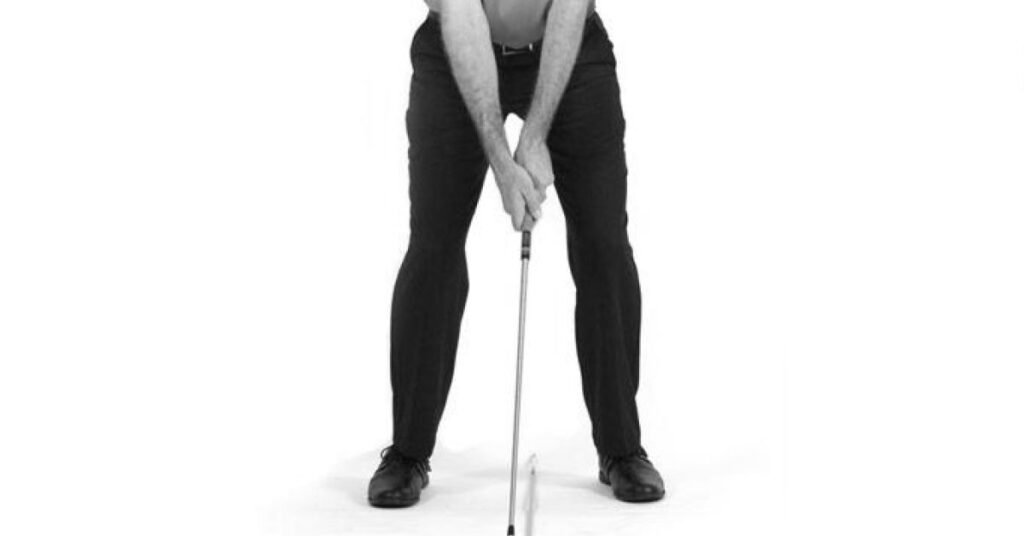
With benefits to both wide and narrow stances, how do you determine the optimal foot positioning for your body type, swing, and shots? Use experimentation, evaluation, and customization to dial in your ideal set-up.
Experimentation and Practice
The best way to find your optimal stance width is through experimentation and practice. Work across the spectrum from narrow to wide.
- Start with feet together, then widen incrementally to find your minimum width for balance.
- Progress outward to explore maximum width before restrictions set in. Identify your range.
- Make practice swings at each width, observing a sense of balance, stability, mobility, and rhythm.
- Pay particular attention to the consistency of contact and preventing mishits like fat, thin, or tops.
- Try a range of stances with different clubs to see the effects. Evaluate full swing vs. partial swing mechanics.
- Use impact tape or powder spray to examine the quality of ball-striking with each stance.
- Focus on a stance width that keeps you centered throughout the swing and prevents swaying off the ball.
- Ideally practice under the guidance of a teaching pro who can monitor your balance, mechanics, and ball flight.
Through purposeful practice across a spectrum of widths, zero in on the foot positioning that optimizes your balance, mobility, and consistency for all clubs. Re-evaluate as your swing evolves.
Evaluating Your Swing
In addition to experimenting, also examine your existing swing mechanics for clues on ideal width.
- If you tend to sway laterally or fall backward during your swing, a wider stance could improve stability.
- If your torso or shoulders feel too restricted during the backswing, a slightly narrower stance could allow more mobility.
- Check for slide versus turn by observing wear patterns on your shoes. Too much outer heel wear indicates slide.
- Analyze video of your swing to see if your head drops or rises during motion, often caused by poor weight transfer.
- Notice if you typically make solid contact or mis-hits like tops and chunks. This could indicate stance imbalance.
Assess your balance, weight shift, and mechanics to determine if a wider or narrower base could correct any deficiencies while swinging.
Consulting a Pro
Working with a PGA teaching professional can provide tremendous insight into your optimal stance width.
- They can analyze your swing mechanics, balance, rhythm, and typical mis-hits to recommend ideal foot positioning.
- During professional club fitting, they will evaluate your stance as part of the customization process.
- Private lessons allow hands-on adjustment and real-time feedback on your stance while swinging.
- Group clinics provide the opportunity to experiment with different stances under pro guidance.
Take advantage of expert instruction to refine your stance for consistency and power.
Adjusting for Different Shots
Also, adjust your width situationally based on the shot at hand. Widen or narrow your stance for shot shaping.
- Take a wider base for woods and long irons requiring power and stability.
- Utilize a narrower stance for wedges and short game requiring precision.
- Widen stance for long forced carries or windy conditions demanding strength.
- Narrow stance for finesse shots around greens needing subtle trajectory manipulation.
Vary width as required for control, distance, and trajectory on different clubs and conditions.
Optimizing your stance width takes experimentation, self-analysis, expert input, and custom adjustments. Dial in proper foot positioning for your swing.
Drills and Tips for Good Stance Alignment
Consistently aligning your feet and body in an optimal stance requires practice and purposeful drills. Try these training techniques and tips for improving setup position.
Alignment Rods
Alignment rods are a useful tool for consistently spacing your feet properly in your stance width.
- Place two rods or clubs outside your feet extending back behind you to guide width.
- Rods provide instant feedback if stance gets too narrow or wide during practice swings.
- Start with rods spaced about shoulder-width apart as a reference point.
- Adjust inward or outward to find your ideal stance width through repetition.
- Rods ensure you resume the proper width after each swing.
Alignment rods establish muscle memory for your optimal stance width for consistency.
Box Drill
The box drill trains your feet to align perpendicular to the target line.
- Place two boards, boxes, or clubs on the ground to represent your stance width.
- Take your set-up with each foot positioned parallel against a box edge.
- As you take practice swings, focus on keeping feet aligned to the box without touching.
- Boxes provide tactile feedback when feet deviate sideways, correcting alignment.
- Start with a conservative width then expand outward to find optimal foot positioning.
Swinging between boxes engrains proper foot alignment and appropriate flair.
Impact Bag Drill
Hitting an impact bag can help develop balance and stability in your stance.
- Assume your stance in front of the bag at proper width and posture.
- Make practice swings focused on maintaining posture through impact.
- Allow the club to strike the bag while holding the finish position without wavering.
- Impact bag provides feedback on balance, weight transfer, and stability.
- Progressively increase the force of the swing against the bag without losing form.
Resisting the impact bag strengthens the core and prevents swaying.
Mirror Check
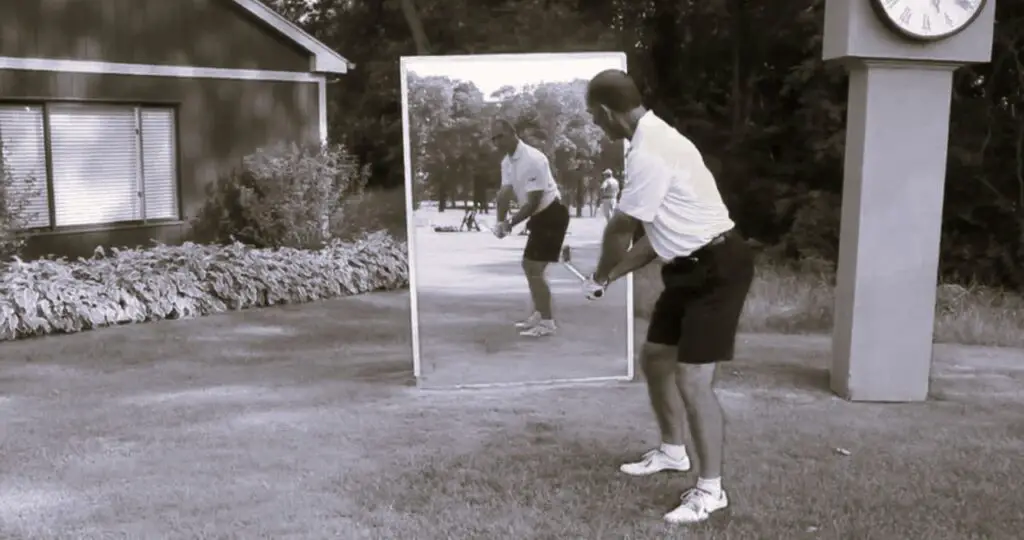
Frequently checking your stance in a mirror can reinforce optimal alignment.
- Observe foot positioning and spacing in the mirror after taking your stance.
- Confirm shoulder alignment and spine angle relative to the target line.
- Validate flex in knees and arms as well as weight distribution.
- Use the mirror to match your setup to a proven model stance.
- Ingraining the look of a proper stance helps reproduce it consistently.
Mirrors provide immediate visual confirmation and feedback on stance.
Proper Foot Positioning
In refining stance alignment, pay particular attention to proper foot positioning.
- Feet should be shoulder-width apart, allowing knees to align over feet.
- Point toes outward slightly to allow hips room to rotate in the swing.
- Maintain even weight distribution between lead and rear foot.
- Experiment with different foot widths to find optimal power and balance.
- Consistently aligning feet correctly establishes platform for efficient mechanics.
Precise foot positioning sets the foundation for your ideal golf stance.
Conclusion
Selecting the appropriate stance width is an important factor in building an efficient, consistent golf swing. While some players prefer a wider stance and others opt for a more narrow footing, your ideal position is specific to your physical attributes and mechanics. Customizing your foot positioning based on body type, flexibility, swing motions, and shot requirements allows you to optimize both power and control.
Through experimentation across a spectrum of widths, focus on a stance that keeps you balanced and centered without swaying off the ball during the swing. Widen your base for stability when using drivers and long clubs that demand force and rotation. Narrow your stance for wedges and short-game finesse shots requiring precision. Adjust foot position situationally based on club, conditions, and desired shot shape.
Analyze your balance, weight shift, and mechanics. A wider stance can improve stability if you tend to sway or fall backward. A more narrow base allows greater mobility if your shoulders and arms feel too restricted in the backswing. Consult golf instructors to evaluate your stance based on video and personalized recommendations.
Refine foot positioning and alignment through purposeful drills. Use alignment rods to ingrain proper spacing. Practice swinging between boards or boxes to correct flair. Hit an impact bag to develop balance and stability. Frequently check your setup in a mirror and solidify optimal posture. Consistent precision with foot alignment establishes a solid foundation.
While general guidelines apply, your optimal stance width combines subjective comfort with personalized effectiveness. Find the foot positioning that stabilizes your body while allowing free rotational force. With practice for consistency, your customized golf stance acts as the launching pad for powerful, accurate shot-making.

